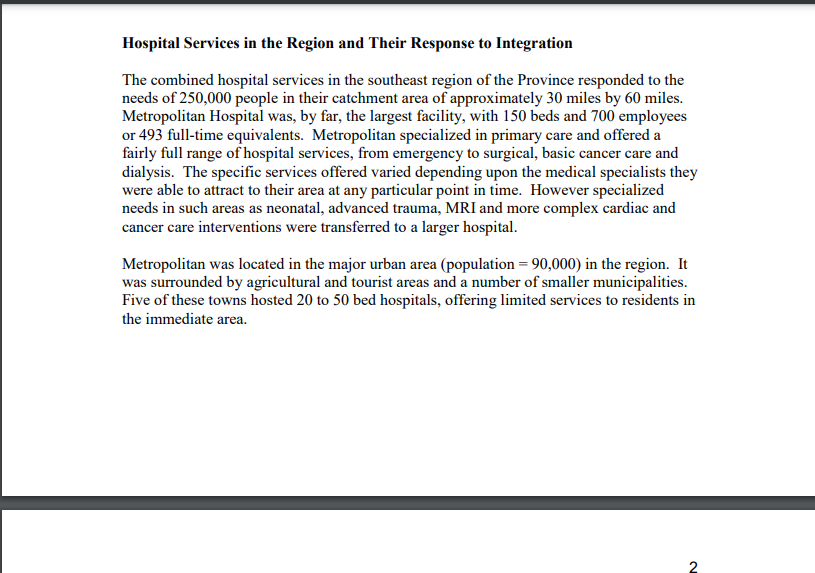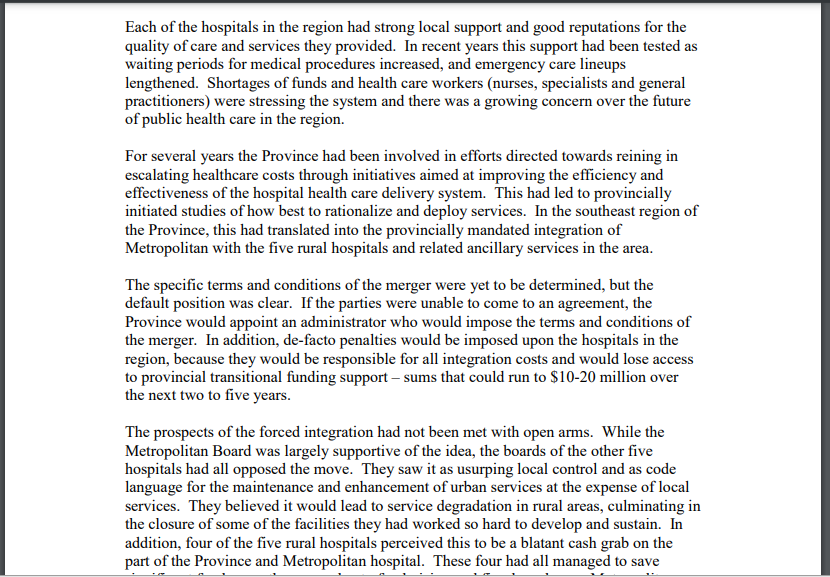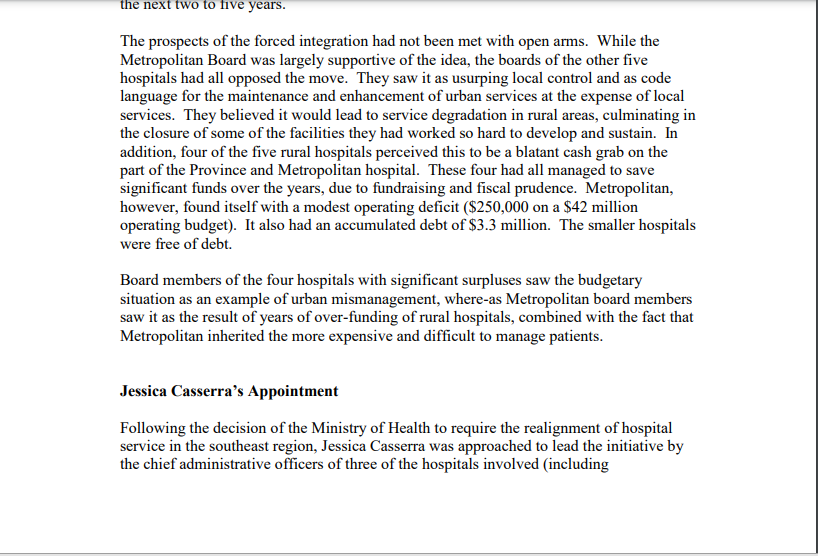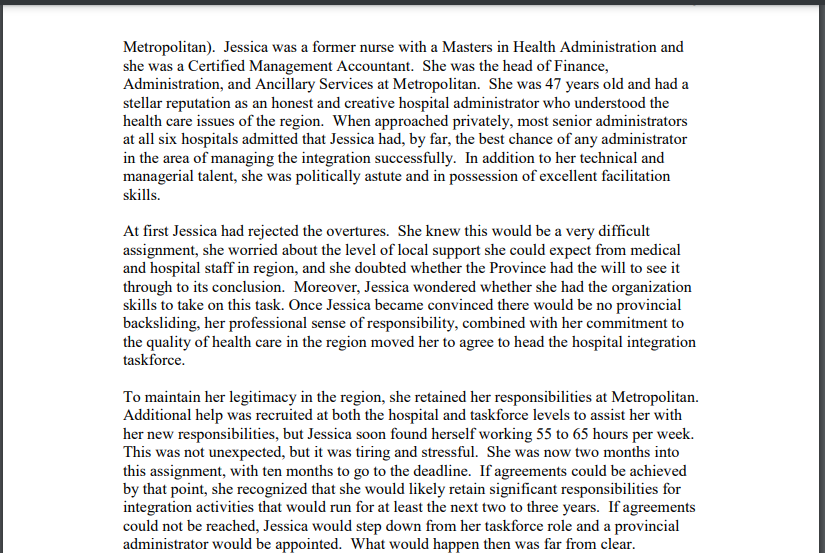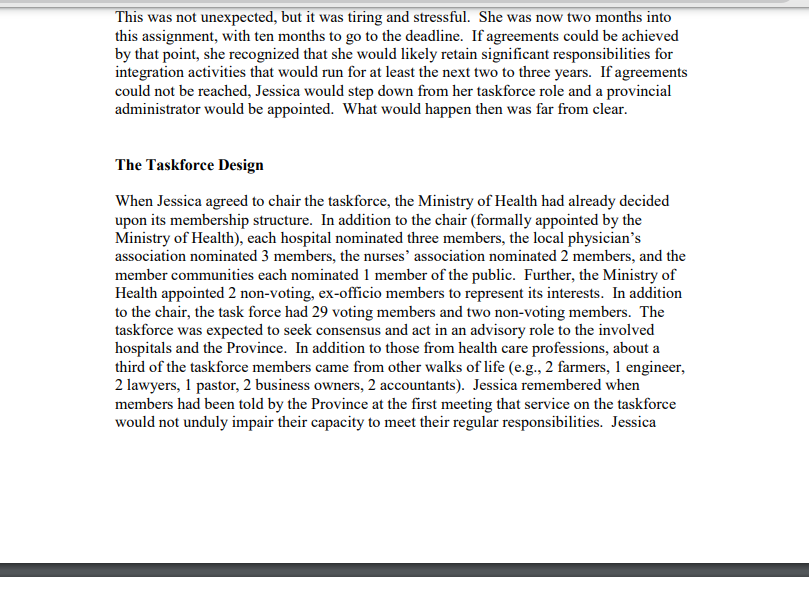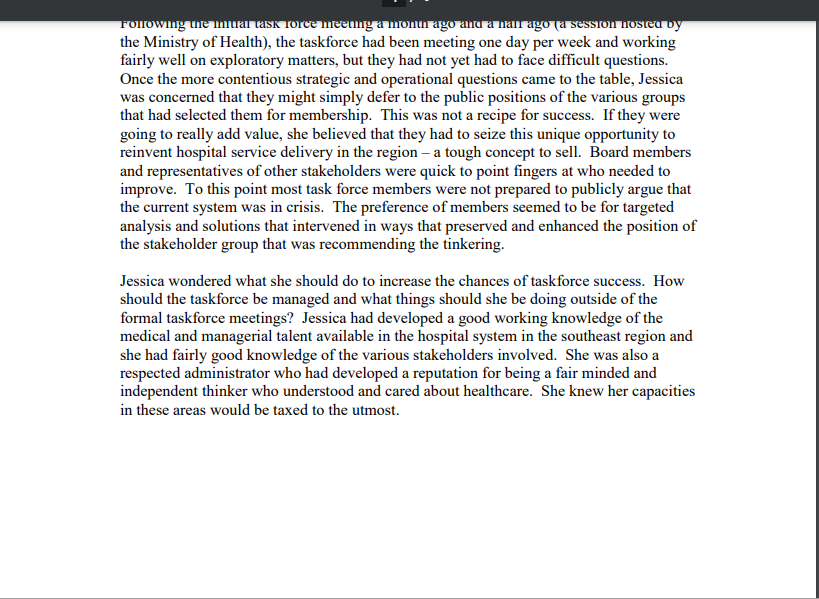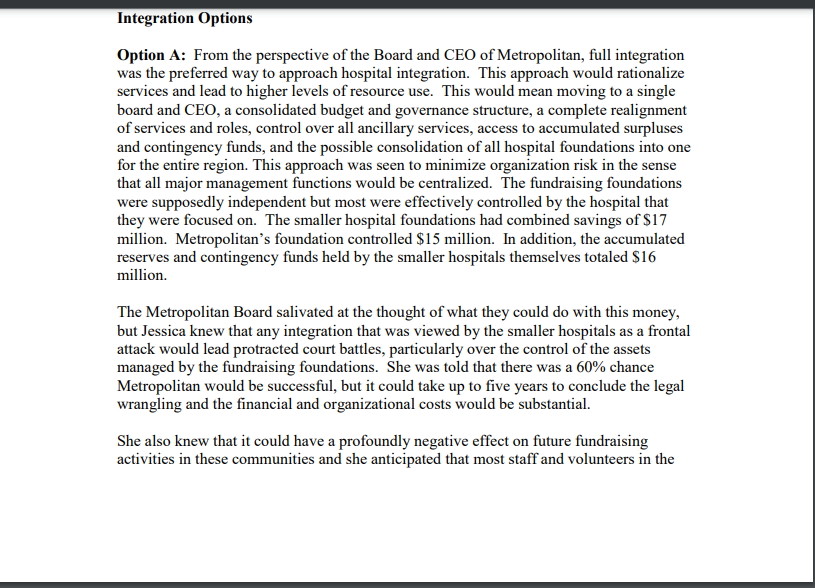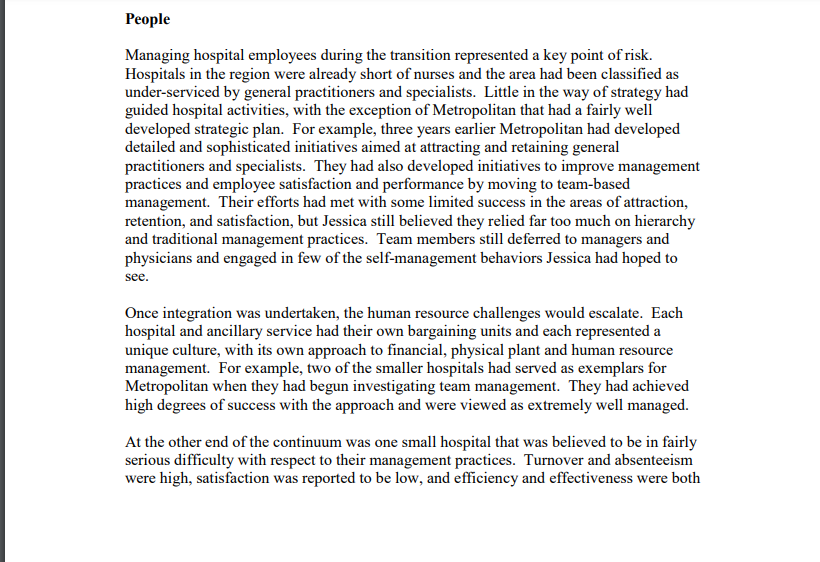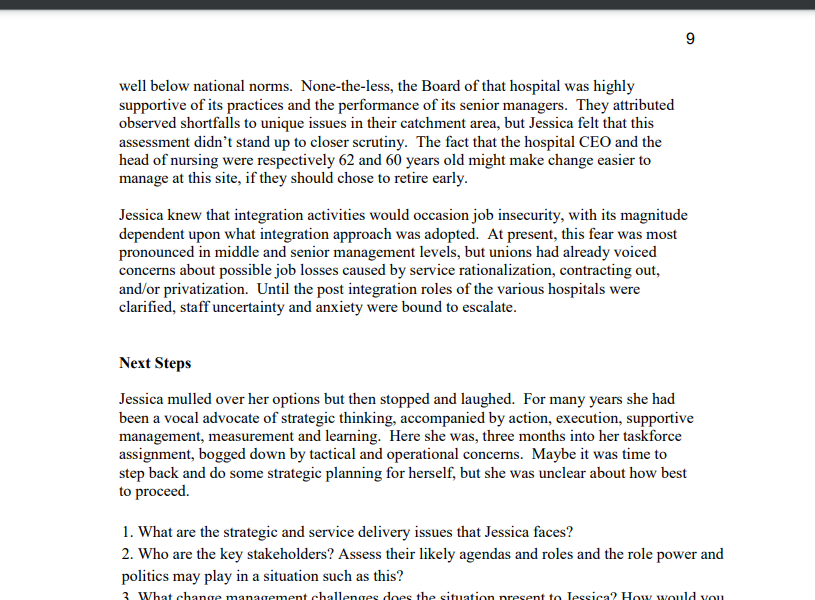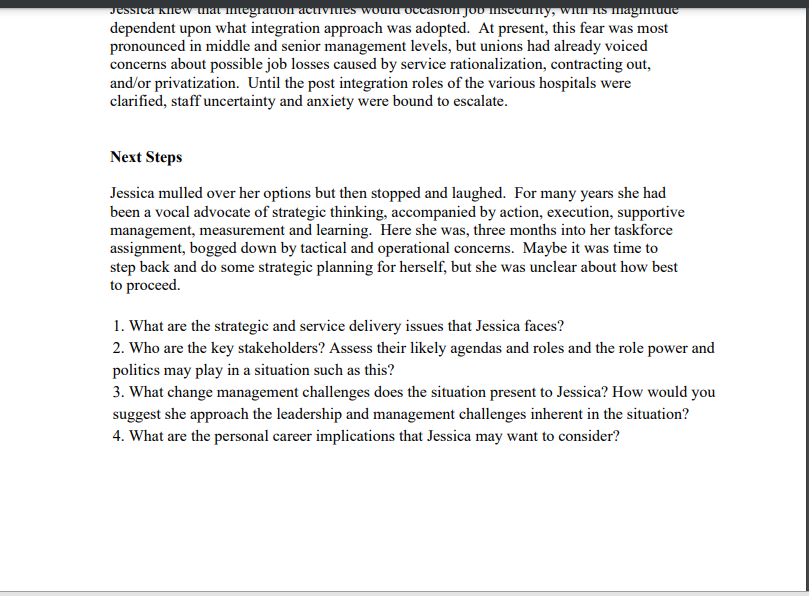The question is at the bottom
Jessica Casscrra' 5 Task Force: Hospital Integration in the Region of Erie Jessica Casserra stretched back from the monitor and rubbed her eyes. Technology had made it possible to be home in the evenings with her family, but as they pointed out, that didn't mean the},r saw much of her. For the past Mo months, most evenings and weekends had been spent pouring over internal reports, briefs, governmental documents, spreadsheets, and consulting studies concerning the integration of hospital services in the Region of Erie. The taxpayers of the Region had received far more than their fair share of her time, but she wasn't sure that was translating into added value. Budgeting, control, program integration, human resource and organization design issues had not been resolved they had only festered as senior hospital management, board members and key stakeholders groups squabbled and continued to avoid making difficult decisions. Nonetheless, the formal organizational integration of Metropolitan with ve smaller hospitals and ancillary services (e.g., laundry, food services] was required to be agreed to and set in motion within ten months. The Ministry of Health had fixed the timing. It was extremely unlikely the provincial governing party Would back down from the start date, given the political heat they had taken throughout the review process that resulted in their decision to regionalize hospital services. Jessica knew they Would not want to give integration opponents additional opportunities to mobiliZe resistance or any hope that decisions might be reversed. They would also want this matter long past prior to the next provincial election. AI._.'I1_.__.'_._..._.._.I"I1L_._:.. Hospital Services in the Region and Their Response to Integration The combined hospital services in the southeast region of the Province responded to the needs of 250,000 people in their catchent area of approximately 30 miles by 60 miles. Metropolitan Hospital was, by far, the largest facility, with 150 beds and 1'00 employees or 493 full-time equivalents. Metropolitan specialiZed in primary care and offered a fairly full range of hospital services, from emergency to surgical, basic cancer care and dialysis. The specic services offered varied depending upon the medical specialists they were able to attract to their area at any particular point in time. However specialized needs in such areas as neonatal, advanced trauma, MRI and more complex cardiac and cancer care interventions were transferred to a larger hospital. Metropolitan was located in the major urban area If population = 90,000} in the region. It was surrounded by agricultural and tourist areas and a number of smaller municipalities. Fit-'e of these toms hosted 20 to 50 bed hospitals, offering limited services to residents in the immediate area. Each of the hospitals in the region had strong local support and good reputations for the quality of care and services they provided. In recent years this support had been tested as waiting periods for medical procedures increased, and emergency care lineups lengthened. Shortages of funds and health care workers (nurses, specialists and general practitioners} were stressing the syswm and there was a growing concern over the future of public health care in the region. For several years the Province had been involved in efforts directed towards reining in escalating healthcare costs through initiatives aimed at improving the efciency and effectiveness of the hospital health care delivery system. This had led to provincially initiated studies of how best to rationalize and deploy services. In the southeast region of the Province, this had translated into the provincially mandated integration of Metropolitan with the ve rural hospitals and related ancillary services in the area. The specic terms and conditions of the merger were yet to be determined, but the default position was clear. If the parties were unable to come to an agreement, the Province Would appoint an administrator who Would impose the terms and conditions of the merger. In addition, de-facto penalties would be imposed upon the hospitals in the region, because theyr would be responsible for all integration costs and would lose access to provincial transitional funding support sums that could run to $10-20 million over the next two to ve years. The prospects of the forced integration had not been met with open arms. While the Metropolitan Board was largely supportive of the idea, the boards of the other five hospitals had all opposed the move. They saw it as usurping local control and as code language for the maintenance and enhancement of urban services at the expense of local services. They beliEVed it Would lead to servico degradation in rural areas, culminating in the closure of some of the facilities they had Worked so hard to develop and sustain. In addition, four of the five rural hospitals perceived this to be a blatant cash grab on the part of the Province and Metropolitan hospital. These four had all managed to save the next two to five years. The prospects of the forced integration had not been met with open arms. While the Metropolitan Board was largely supportive of the idea, the boards of the other five hospitals had all opposed the move. They saw it as usurping local control and as code language for the maintenance and enhancement of urban services at the expense of local services. They believed it would lead to service degradation in rural areas, culminating in the closure of some of the facilities they had worked so hard to develop and sustain. In addition, four of the five rural hospitals perceived this to be a blatant cash grab on the part of the Province and Metropolitan hospital. These four had all managed to save significant funds over the years, due to fundraising and fiscal prudence. Metropolitan, however, found itself with a modest operating deficit ($250,000 on a $42 million operating budget). It also had an accumulated debt of $3.3 million. The smaller hospitals were free of debt. Board members of the four hospitals with significant surpluses saw the budgetary situation as an example of urban mismanagement, where-as Metropolitan board members saw it as the result of years of over-funding of rural hospitals, combined with the fact that Metropolitan inherited the more expensive and difficult to manage patients. Jessica Casserra's Appointment Following the decision of the Ministry of Health to require the realignment of hospital service in the southeast region, Jessica Casserra was approached to lead the initiative by the chief administrative officers of three of the hospitals involved (includingMetropolitan]. Jessica was a former nurse with a Masters in Health Administration and she was a Certied Management Accountant. She was the head of Finance, Administration, and Ancillary Services at Metropolitan. She was 47 years old and had a stellar reputation as an honest and creative hospital administrator who understood the health care issues of the region. When approached privately, most senior administrators at all six hospitals admitted that Jessica had, by far, the best chance of any administrator in the area of managing the integration successfully. In addition to her technical and managerial talent, she was politically astute and in possession of excellent facilitation skills. At rst Jessica had rejected the overtures. She knew this would be a very difcult assignment, she Worried about the level of local support she could expert from medical and hospital staff in region, and she doubted whether the Province had the will to see it through to its conclusion. Moreover, Jessica wondered whether she had the organization skills to take on this task. Once Jessica became convinced there would be no provincial backsliding, her professional sense of responsibility, combined with her commitment to the quality of health care in the region moved her to agree to head the hospital integration taskforce. To maintain her legitimacy in the region, she retained her Msponsihilities at Metropolitan. Additional help was recruited at both the hospital and taskforce leVels to assist her with her new responsibilities, but Jessica soon found herself working 55 to 65 hours per week. This was not unexpected, but it was tiring and stressful. She was now tWo months into this assignment, with ten months to go to the deadline. If agreements could be achieved by that point, she recogniZed that she Would likely retain signicant responsibilities for integration activities that would run for at least the next two to three years. If agreements could not be reached, Jessica would step down from her taskforce role and a provincial administrator would be appointed. What would happen then was far from clear. This was not unexpected, but it was tiring and stressful. She was now two months into this assignment, with ten months to go to the deadline. If agreements could he achieved by that point, she recognized that she would likely retain signicant responsibilities for integration activities that would run for at least the next two to three years. If agreements could not be reached, Jessica would step down from her taskforce role and a provincial administrator would be appointed. What would happen then was far from clear. The Taskl'orce Design Wh- Jessica agreed to chair the taskforce, the Ministry of Health had already decided upon its membership structure. In addition to the chair (fonnally appointed by the Ministry of Health), each hospital nominated three members, the local physician's association nominated 3 mernhers, the nurses' association nominated 2 mernhers, and the member commuuities each nominated 1 member of the public. Further, the Ministry of Health appointed 2 non-voting, eat-o'icio members to represent its interests. In addition to the chair, the task force had 29 voting members and two non-voting members. The taskforee was expected to seek consensus and act in an advisory role to the involved hospitals and the Province. In addition to those from health care professions, about a third of the taskforcc members came from other walks of life (cg, 2 farmers, l engineer, 2 lawyers, 1 pastor, 2 business owners, 2 accountants}. Jessica remembered when members had been told by the Province at the rst meeting that service on the taskforce would not unduly impair their capacity to meet their regular responsibilities. Jessica reckoned that since that first meeting, task force duties had taken 20 to 30 hours per week of her time and about 10 hours per week of the time of other members. The taskforce had adequate funds to hire professional staff, consultants, and support personnel to help them in their deliberations. They had a full-time staff of 3 including two hospital planners, an information systems specialist, a human resource specialist, a nancial specialist, and 3 staff supports. These employees were hired directly by the task force through the efforts of Jessica and her staff sub-committee. In addition, consultants had received contracts from the task force to assist in the needed background work and analysis. They included two well-respected retired hospital CEO's who were contracted to investigate service structure and delivery options. I.Cltnce implementation of the plan became the focus, an irnplementation taskforce Would be formed. It was anticipated that most implementation taskforce members would be drawn from the existing hospital staff, but it had yet to be designed. The staff of the task force was housed in office space supplied by the Region of Erie and the task force used Erie's council chamber for its meetings. In addition, there was temporary ofce space and a board room available to task force members, and I essica had permanent ofce space available to her there. Following the initial task force meeting a month ago and a halfago {a session hosted by the Ministry of Health), the taskforce had been meeting one day per Week and working fairly well on eXploratory matters, but they had not yet had to face difcult questions. Once the more contentious strategic and operational questions came to the table, Jessica was concerned that they might simply defer to the public positions of the various groups that had selected them for membership. This was not a recipe for success. If they were going to really add value, she believed that they had to seize this unique opportunity to reinvent hospital service delivery in the region a tough concept to sell. Board members and representatives of other stakeholders were quick to point ngers at who needed to the Ministry of Hea L the taskforce had een meeting one da per w and working fairly well on exploratory matters, but they had not yet had to face difcult questions. Once the more contentious strategic and operational questions came to the table, Jessica was concerned that they might simply defer to the public positions of the various groups that had selected them for membership. This was not a recipe for success. If they were going to really add value. she believed that they had to seize this unique opportunity to reinvent hospital service delivery in the region a tough concept to sell. Board members and representatives of other stakeholders were quick to point ngers at who needed to improve. To this point most task force members were not prepared to publicly argue that the current system was in crisis. The preference of members seemed to be for targeted analysis and solutions that intervened in ways that preserved and enhanced the position of the stakeholder group that was recommending the tinkering. Jessica wondered what she should do to increase the chances of taskforce success. How should the taskforce be managed and what things should she be doing outside of the formal taskforce meetings? Jessica had developed a good working knowledge of the medical and managerial talent available in the hospital system in the southeast region and she had fairly good knowledge of the various stakeholders involved. She was also a respected administrator who had developed a reputation for being a fair minded and independent thinker who understood and cared about healthcare. She knew her capacities in these areas would be taxed to the utrnost. The Strategic Questions From a strategic perspective, Jessica continued to ponder what would be the best way to integrate hospital services and congure their management and governance structures, systems, and supports. There were a range of options, but all came with strings attached. When thinking about the integration challenge, Jessica was very aware of the fact that Metropolitan had a well-developed strategic plan that had already contemplated some of these questions. However, she also believed these documents would likely be more of an impediment than an aid at this time. Two of the smaller hospitals had made some attempt at developing a strategic plan for themselves while the other three had spent little time engaged in such activity. However, virtually all the hospital CEO's and their senior managers seemed to believe that they were skilled strategists who knew what the region needed. If the services offered by a newly constructed regional hospital delivery system were to be as effective and efcient as possible, Jessica knew that the hospitals would have to depart drammcally from the way they had organized themselves in the past. At present, Jessica did not have a strong sense of the strategic focus or skill set of most taskforce members, but it was her belief that many would be tempted to defer to the various groups that had nominated them. Integration Options Option A: From the perspective of the Board and CEO of Metropolitan, full integration was the preferred way to approach hospital integration. This approach would rationalize services and lead to higher levels of resource use. This would mean moving to a single board and CEO, a consolidated budget and governance structure, a complete realignment Integration Options Option A: From the perspective of the Board and CEO of Metropolitan, full integration was the preferred way to approach hospital integration. This approach would rationalize services and lead to higher levels of resource use. This would mean moving to a single board and CEO, a consolidated budget and governance structure, a complete realignment of services and roles, control over all ancillary services, access to accumulated surpluses and contingency funds, and the possible consolidation of all hospital foundations into one for the entire region. This approach was seen to minimize organization risk in the sense that all major management functions would be centralized. The fundraising foundations were supposedly independent but most were effectively controlled by the hospital that they were focused on. The smaller hospital foundations had combined savings of 181']Ir million. Men-opclitan's foundation controlled $15 million. In addition, the accumulated reserves and contingency fuuds held by the smaller hospitals themselves totaled $16 million. The Metropolitan Board salivated at the thought of what they could do with this money, but Jessica knew that any integration that was viewed by the smaller hospitals as a frontal attack would lead protracted court battles, particularly over the control of the assets managed by the fundraising foundations. She was told that there was a 60% chance Metropolitan Would be successful, but it could take up to ve years to conclude the legal wrangling and the nancial and organizational costs would be substantial. She also knew that it could have a profoundly negative effect on future fundraising activities in these communities and she anticipated that most staff and volunteas in the smaller hospitals would view the approach very negatively. Staff resistance would likely come in the form of absenteeism, less willingness to work overtime and extra shifts, and resignations by nurses and physicians. Only the staff at Metropolitan, most of the medical specialists and some of the GP's would be likely to view this option positively, due to their beliefs concerning the need for the infusion of funds to shore up their ability to supply new and higher quality leading edge medical care to citizens in the region. Option B: At the other end of the integration continuum was a model that would allow all hospitals to retain their independent structures and boards, with member hospitals each nominating representatives to a supra Board that would act as a planning and coordinating body. This was the option that was favored by the smaller hospitals and towns, because it allowed continued local access and control of the institutions that the smaller communities had been instrumental in developing and supporting. Neither Metropolitan not the Province viewed this model favorably, because it seemed likely to perpetuate fairly siloed operations and did not seem likely to result in significant savings from consolidation and increased efficiency. These potential savings were thought to be in the order of at least $4 to $6 million per year. Given the position of the Province, this would leave Metropolitan scrambling to find ways to fund an operating deficit likely to grow by $100,000 to $350,000 per year over the next few years as the population aged and the smaller hospitals continued downloading their more difficult and expensive cases. Between these two extremes there were many other possibilities and Jessica knew that these needed to be narrowed, developed and assessed. In addition, there was the wild card issue of how to best handle chronic, long-term care in the region, but task force members and the Province seemed prepared to set this issue aside for the present. Competitionmembers and the Province seemed prepared to set this issue aside for the present. Competition Competition was becoming more intense - somewhat surprising because this was not supposed to happen in a publicly funded system. Competition came from several sources. Private clinics had opened in or near the southeast region and were offering a number of services that had previously been supplied by Metropolitan. Hospitals had found that these specific services were financially attractive to supply because they were relatively easy to perform, in many cases patients (or insurers) paid for the service themselves, and in other cases the provincial reimbursement rate greatly exceeded the costs of supplying the services. Cosmetic surgery, routine hernia treatment, rehabilitation services, CT services, and diet and lifestyle counseling were the types of services that were coming under increased competitive pressure. In addition, residents in the area could easily access private medical facilities by crossing into the United States. A number of these facilities were actively marketing their services to Canadians and it was not unusual to find Canadian physicians affiliated in some way, with these U.S. facilities. Jessica noted that the Provincial government was willing to pay U.S. suppliers the provincially mandated rates for insured services. Individual7 patients were responsible for any differences, but for procedures such as CT's and MRI's, the provincial payments covered the majority of the bill. Ancillary Services Ancillary services represented both a competitive opportunity and threat. Metropolitan Hospital, in particular, was in the catering, vehicle repair, fundraising, payroll services, security, housekeeping/cleaning, hazardous material handling, homecare and laundry businesses, to name just a few. These were services that they could potentially commercialize and/or privatize and spin off. While Jessica had only begun inspecting these opportunities, she already knew that some were fairly efficient and effective operations - laundry, payroll services, and food services, in particular. Others (custodial/cleaning services and homecare) were less efficient and cost effective than private sector competitors at the present. It was not clear how she should go about structuring and evaluating these opportunities and risks. Several Board members looked at such initiatives very favorably, because they saw them as a way to address deficit problems and provide funding for mainstream medical care delivery. However, a minority continued to have serious concerns about the commercialization of hospital services. Equipment and physical plant were, on the whole, in a fairly good state of repair in the region. Equipment was never as modern or as abundant as staff would like, but overall the hospitals had managed maintenance programs well. Jessica recognized that some of the commercialization opportunities would require significant investments in order to realize their potential. For example, the laundry facility required an investment of $13 million to allow it to take advantage of the7 /9 Jessica recognized that some of the commercialization opportunities would require significant investments in order to realize their potential. For example, the laundry facility required an investment of $13 million to allow it to take advantage of the commercialization opportunities in the area (supplying hospitals, nursing homes, the University and Community College, and others in need in institutional laundry services). While the laundry, in particular, seemed to have solid economic potential, she recognized that some would argue that the resources were needed to fund hospital plant and equipment needs that more directly served the delivery of medical services. Control and Information Systems With the exceptions of Metropolitan's computerized accounting and payroll systems, computer information systems represented a serious point of concern. Each hospital had its own system or systems and the systems did not communicate with each another. Some of these were clearly antiquated and even within Metropolitan there was duplication of information entry, difficulties with information flow, and far too much reliance on paper. Jessica knew that the issues in the areas of control system design extended well beyond software and computer concerns. Ministry of Health and Ministry of Finance3 requirements drove much of the activity in this area, but Jessica felt that this would be an ideal time to sort through and establish the management contml information that could really benet managers and the organization. For example, there was little to no consistency in the boundary, belief, diagnostic or interactive control systems in operation in the various hospitals. Metropolitan's system was the most developed, but even here Jessica believed improvement was needed with both its design and use. She believed the new organization Would be well served if it approached the design of the control system with an open mind and the: insured that their managers were literate in the effective use of the information emanating from it. The critical questions concerning the control system were what should the system he designed to do and how should its implementation be approached? Jessica believed these would be impossible to determine in a denitive way until the fundamental strategy questions had been answered. She knew that gaining interest and approval for control system initiatives (other than those required by statute] Would be a challenge. However, building the business case for control processes that went beyond historical reporting requirements would get progressively more difficult as time passed and resources tightened. People Managing hospital employees during the transition represented a key point of risk. Hospitals in the region were already short of nurses and the area had been classified as Under-serviced by general practitioners and specialists. Little in the way of strategy had guided hospital activities, with the exception of Metropolitan that had a fairly well developed strategic plan. For e ple, three years earlier Metropolitan had developed I'd. .nl III :'II .'I .III. People Managing hospital employees during the transition represented a key point of risk. Hospitals in the region were already short of nurses and the area had been classied as Under-serviced by general practitioners and specialists. Little in the way of strategy had guided hospital activities, with the exception of Metropolitan that had a fairly well developed strategic plan. For example, three years earlier Metropolitan had developed detailed and sophisticated initiatives aimed at attracting and retaining general practitioners and specialists. They had also developed initiatives to improve management practices and employee satisfaction and performance by moving to team-based management. Their efforts had met with some limited success in the areas of attraction, retention, and satisfaction, but Jessica still believed they relied far too much on hierarchy and traditional management practices. Team members still deferred to managers and physicians and engaged in few of the self-management behaviors Jessica had hoped to see. Once integration was undertaken, the human resource challenges would escalate. Each hospital and ancillary service had their own bargaining units and each represented a Unique culture, with its ovvn approach to fmancia], physical plant and human resource management. For example, two of the smaller hospitals had served as exemplars for Metropolitan when they had begun investigating team management. They had achieved high degrees of success with the approach and were viewed as extrernely well managed. At the other end of the continuum was one small hospital that was believed to be in fairly serious difficulty with respect to their management practices. Turnover and absenteeism were high, satisfaction was reported to be low, and efficiency and effectiveness were both 9 well below national norms. None-the-less, the Board of that hospital was highly supportive of its practices and the performance of its senior managers. They attributed observed shortfalls to unique issues in their catchment area, but Jessica felt that this assessment didn't stand up to closer scrutiny. The fact that the hospital CEO and the head of nursing were respectively 62 and 60 years old might make change easier to manage at this site, if they should chose to retire early. Jessica knew that integration activities would occasion job insecurity, with its magnitude dependent upon what integration approach was adopted. At present, this fear was most pronounced in middle and senior management levels, but unions had already voiced concerns about possible job losses caused by service rationalization, contracting out, and/or privatization. Until the post integration roles of the various hospitals were clarified, staff uncertainty and anxiety were bound to escalate. Next Steps Jessica mulled over her options but then stopped and laughed. For many years she had been a vocal advocate of strategic thinking, accompanied by action, execution, supportive management, measurement and learning. Here she was, three months into her taskforce assignment, bogged down by tactical and operational concerns. Maybe it was time to step back and do some strategic planning for herself, but she was unclear about how best to proceed. 1. What are the strategic and service delivery issues that Jessica faces? 2. Who are the key stakeholders? Assess their likely agendas and roles and the role power and politics may play in a situation such as this? WhatJessica Knew That Integration activities would occasion job misecurity, with Its magnitude dependent upon what integration approach was adopted. At present, this fear was most pronounced in middle and senior management levels, but unions had already voiced concerns about possible job losses caused by service rationalization, contracting out, and/or privatization. Until the post integration roles of the various hospitals were clarified, staff uncertainty and anxiety were bound to escalate. Next Steps Jessica mulled over her options but then stopped and laughed. For many years she had been a vocal advocate of strategic thinking, accompanied by action, execution, supportive management, measurement and learning. Here she was, three months into her taskforce assignment, bogged down by tactical and operational concerns. Maybe it was time to step back and do some strategic planning for herself, but she was unclear about how best to proceed. 1. What are the strategic and service delivery issues that Jessica faces? 2. Who are the key stakeholders? Assess their likely agendas and roles and the role power and politics may play in a situation such as this? 3. What change management challenges does the situation present to Jessica? How would you suggest she approach the leadership and management challenges inherent in the situation? 4. What are the personal career implications that Jessica may want to consider

